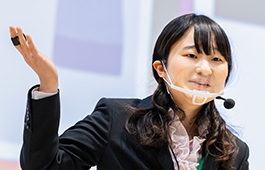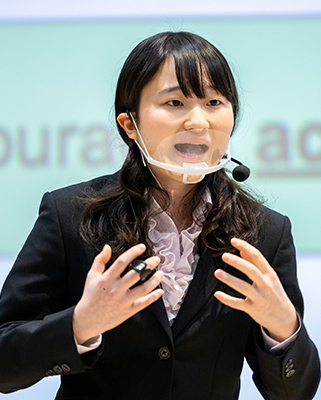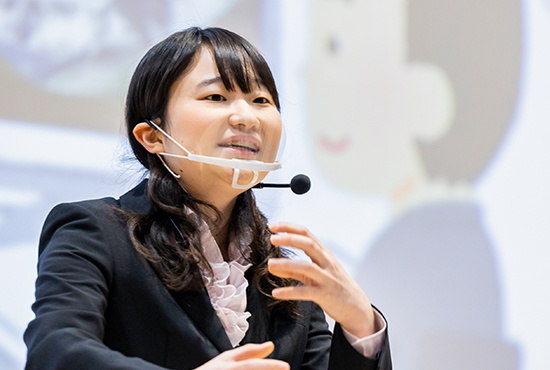




宮田 果歩さん
Miyata Kaho
国際基督教大学 教養学部 4年
Hello, my name is Kaho Miyata. I’m going to propose a new educational system in Japan for the future generation.
Please think back to this April. Do you remember going and seeing the cherry blossoms? Most people would say “No”. Why?
Because at that time, Coronavirus threatened our daily lives and we have experienced great loss. Many students cannot go to school and cannot meet their friends.
However, we can see other possibilities and future opportunities because of coronavirus. Now, it is time to look for new prospects. Why don’t we think about the future of education together?

As a new educational system, I propose a combination of traditional learning and online learning because this pandemic made us realize both learning styles have their own benefits.
In this presentation, I suggest how this system works and how it benefits Japanese students. But first of all, what do we need to achieve this learning style? Yes, it is necessary to provide ICT devices and the means to use them.
Do you know what ICT is? ICT means information and communication technology. Examples of ICT devices are computer, iPhone and tablet, which facilitate interaction with the digital world.
I have a question. Is it possible to distribute and use ICT devices in Japan today?
Let’s look at the graphs. It shows the percentage of teachers who use ICT devices in the classroom. Please look at Japan's rate. Only 17.9 percent of teachers use ICT devices. This rate is the lowest among OECD countries.
Also, when we look at ICT utilization rate in school and out of school from 2009 to 2018, the rate in Japan has not changed through the years. Therefore, in the coronavirus pandemic, some school has not been ready for using ICT devices. So, how to overcome this situation?
In 2019, the Ministry of Education suggested "GIGA school concept." GIGA means Global and Innovation Gateway for All. It aims for one device for each student.
In this concept, they decided to invest 180 billion yen per year from 2018 to 2022 for ICT devices, Wi-Fi networks, and ICT technicians to schools and houses to ensure students' learning environment. So, students can use these devices even in poor families.
Also, in this concept, teachers will participate in trainings and seminars which provide ICT skills in the classroom. The educators of this training can be ICT technicians who are sent by the government, companies, and NPOs which provide ICT devices to schools.
Then, teachers will instruct their students on ICT skills and information ethics in the classroom. So, I believe the distribution of ICT devices and teaching ICT skills is feasible.
Next, my target audience. My target age groups are middle and high school students because they have capacity to handle ICT devices and understand information ethics.
Let's move on to the main content of this system. I propose a new educational system from three perspectives. First, how to conduct class. Second how to communicate with students, and last how to build a variety of networks.
My first suggestion; I suggest flipped learning to conduct classes, which has already been introduced in some California schools and had a positive impact on students’ performance. In flipped learning, students can listen to lectures at home, and share and discuss their ideas with friends in the classroom.
What are the benefits of Flipped learning? Students can learn at their own pace. Students study anytime and anywhere. It encourages active learning. In a traditional classroom, students mostly listen to teachers' lectures to get new knowledge and information. If they have ICT devices, they can get lots of information and knowledge by themselves. Therefore, in the classroom, they can have a much deeper discussion, and it leads to active learning.
Let’s move on to my second suggestion. I propose students' online support system to assist students and parents more and reduce teachers' stress. Finland has created WILMA, a web-based public information system, and made information transparent for students and their parents.
This is an example of how this system works. Teachers and parents can always check students' attendance, grades, homework and mental conditions.
How this system functions? First, teachers type students’ information and parents and students can see it on their devices. If they have concerns, they can contact or e-mail the teachers.
After that, teachers and counselors talk to students in person and try to solve problems which students have. And again, teachers will report the students’ condition.
What are the benefits of this system? First, teachers share students’ information with parents easily. Second, parents feel relieved to see children’s information anytime. Lastly, students are more likely to open up and be honest about their struggles with the help of ICT devices.

Let’s move on to my third suggestions. Lastly, I offer a program for building relationships between foreigners and students, and workers all over Japan and students.
The first suggestion is the international exchange using ICT devices. Many people cannot afford to go abroad, and in some situations such as coronavirus, we cannot go to other countries. In this program, Japanese schools and overseas schools can become partners and connect their students with ICT devices, and share each country's cultures and values.
After that, students can share and discuss what they learned in this program. It improves students’ English skills. It also broadens students’ perspectives.
The second suggestion is interacting with workers all over Japan. In this program, schools can access a huge database which introduces various kinds of jobs from Hokkaido to Okinawa, and students can see it on their devices and experience if they are interested in it.
If students click Glassworker, they can see job description, job introduction video and students can sign up for tour and trials.
As a result, it gives them a good chance to think about their future job and their interest. And if students think they want to work at some jobs thanks to this program, in the future, it might revitalize declining industry and communities. Therefore, it benefits both students and workers all over Japan. These are the programs I want to propose as a new educational system.
In conclusion, what does this system give students? It maximizes each students’ personality. It provides a comfortable learning environment. It broadens students’ perspectives and gives opportunities to think about their future.
Each child has a unique personality. Some children prefer traditional learning. But some prefer to stay home and take online classes. There is no best option here. The best option for a child is to be in an environment where they learn the best. We should provide a suitable education for each child to expand their possibility.
Let’s support the future children together. Education is necessary for everyone, it creates the foundation of a person’s life.
Thank you for listening.

こんにちは、宮田果歩です。これから日本の未来の子供たちに向けた新しい教育システムを提案したいと思います。
今年の4月を思い出してみてください。お花見に行ったことを覚えていますか? おそらくほとんどの人が「いいえ」と答えるでしょう。それはなぜでしょうか?
なぜならその時、コロナウイルスが私たちの日常を脅かし、私たちは失望していました。多くの生徒が学校に行けず、友達に会うことができませんでした。
しかし、私たちはコロナウイルスのおかげで他の可能性や未来の機会を知ることができます。今、新しい可能性を見つける時です。 一緒に未来の教育を考えませんか?
新しい教育システムとして、従来の教育方法とオンラインでの教育方法を組み合わせることを提案します。なぜなら、この感染症の中で、どちらの学習方法にも良さがあるということに気づいたからです。
このプレゼンテーションでは、このシステムがどのように機能し、日本の生徒にどのような恩恵を与えるかを示します。
まず初めにこの学習スタイルを達成するには何が必要でしょうか?
そうです、ICT機器の提供と、それを使う方法の提供が必須です。
皆さんは、ICTが何か知っていますか? ICTとは情報通信技術のことです。ICT機器の例はコンピューター、iPhone、タブレットなどデジタルの世界との通信を容易にするものです。
では質問です。今の日本ではICT機器を配布し、使うことができるでしょうか?
グラフを見てください。このグラフは学校の教室の中でICT機器を使っている先生の割合です。日本の数値を見てください。たった17.9%の先生しかICT機器を使っていません。この数値はOECD諸国の中で一番低いのです。
また、2009年から2018年までの校内校外におけるICT利用率を見てみると、その間、利用率は変わっていません。そのためコロナウイルスが蔓延しているとき、ICT機器を使う準備ができていない学校もありました。どのようにこの状況を乗り越えたら良いのでしょうか?
2019年、文部科学省が「GIGAスクール構想」を打ち出しました。GIGAは"Global and Innovation Gateway for All"を意味します。 一人に一台ICT機器が行き渡ることを目的としています。
この構想では、2018年から2022年まで、単年度あたり1800億円を生徒の良い学習環境を確保するためにICT機器、WiFiネットワーク、ICT技術者に投資することを決めました。それゆえ、裕福ではない家庭の子どももICT機器を受け取ることができます。
また、この構想では教師がICTスキルを教室で提供できるようにトレーニングとセミナーに参加します。このトレーニングを行う人は、学校にICT機器を提供している政府関係者、会社、NPO法人のICT技術者の人々です。その後、教師は生徒にICTスキルと情報倫理を教室で教えます。よって、ICT機器を配り、ICTスキルを生徒に教えることは可能だと私は思います。
次にこのシステムのターゲットとなる人々についてです。
私がターゲットとする年齢は中学生と高校生です。なぜなら、彼らはICT機器を自分で使い、情報倫理を理解することができるからです。
それでは、このシステムの主要な部分に移っていきましょう。3つの観点から新しい教育システムを提案したいと思います。
1つ目は、授業の行い方。2つ目は生徒とのコミュニケーションの取り方です。3つ目は様々なネットワークの築き方です。
1つ目の提案です。
授業の行い方として、反転授業を提案します。これはいくつかのカルフォルニアの学校ですでに導入されていて、生徒のパフォーマンスに良い影響を与えることが分かっています。
反転授業では、生徒は講義を家で聞き、学校の教室で友達と考えを共有したり、話し合ったりします。
反転授業の良さはなんでしょうか。
生徒は自分のペースで学ぶことができます。生徒はいつでもどこでも勉強することができます。また、それはアクティブラーニングを促します。従来の教室では、新しい情報を得るためにほとんどの時間教師の講義を聞きます。しかし、もしICT機器を持っていたら、生徒は多くの情報や知識を自分自身で得ることができます。よって、教室ではもっと深い議論をすることができます。そしてそれがアクティブラーニングにつながります。
2つ目の提案に移りましょう。
生徒と両親をより支え、教師の負担を減らすためのオンラインサポートシステムを提案します。
フィンランドでは、WILMAというウェブ上の公の情報システムがつくられており、生徒とその両親に情報が行き渡るようになっています。
これは、このシステムがどのように機能するかの例です。
教師と生徒の親は、生徒の出席、成績、宿題や体調をいつでも知ることができます。
このシステムはどのように機能するのでしょうか? まず、教師が生徒の情報を打ち込み、両親と生徒はそれを自分のICT機器で見ることができます。もし何か心配することがあったら、教師に連絡できます。その後、教師とカウンセラーが生徒と直接話し、生徒が抱えている問題を解決しようと努めます。そして、教師はまた生徒の状況について入力します。
このシステムの良さはなんでしょうか?
1つ目は教師が生徒の情報を両親と簡単に共有できることです。2つ目は両親が生徒の情報をいつも見られて安心できることです。そして、3つ目は生徒が自分の抱えている問題をICT機器の助けによって、打ち明けやすくなることです。
では3つ目の提案に移りましょう。 最後に、外国人と生徒、日本中の労働者と生徒をつなぐためのプログラムを提供します。
1つ目はICT機器を使って国際交流することです。多くの生徒が海外に行く金銭的な余裕がなく、またコロナウイルスのような状態下では、他の国に行くことができません。しかしこのプログラムでは日本の学校と海外の学校がパートナーになり、生徒をICT機器でつなぎ、それぞれの国の文化や価値観を共有し合うことができます。
その後、生徒はこのプログラムで学んだことを共有し、話し合えます。それは生徒の英語のスキルを向上させ、また生徒の視野を広げます。
2つ目は日本中の労働者と交流することです。このプログラムでは学校が北海道から沖縄まで色々な種類の職業を紹介している大きなデータベースにアクセスすることができ、生徒はそれをICT機器で見て、もし興味があれば体験しに行くことができます。
例えば、生徒が「ガラス職人」をクリックすると、仕事の内容、仕事を紹介するビデオを見ることができ、職業体験や見学に申し込めます。
その結果、生徒は自分の将来の職業や自分の興味を考えることにつながります。また、もし生徒がこのプログラムのおかげで、将来何かの職業に就きたいと考えた場合、衰退している産業や地域の活性化にもつながります。よって、それは生徒にも、日本中の労働者にも恩恵を与えます。 これらが、私が新しい教育システムとして提案したいプログラムです。
結論として、このシステムは生徒に何を与えるのでしょうか? それぞれの生徒の個性を最大限生かします。生徒に居心地の良い教育環境を与えます。生徒の視野を広げ、将来について考える機会を与えます。
それぞれの生徒にはユニークな個性があります。従来の教育を好む人もいれば、家にいてオンラインで授業を受けるのを好む生徒もいます。そこに優劣はありません。子どもたちにとって一番良いのは、彼らにとって最も適した方法で学べる環境にいることです。よって、それぞれの生徒の可能性を広げるために生徒に合った教育を与えるべきです。 未来の子どもたちを一緒に支えていきましょう。なぜなら教育は全ての人にとって必要なものであり、人々の生活の基礎をつくるものだからです。
ご静聴ありがとうございました。